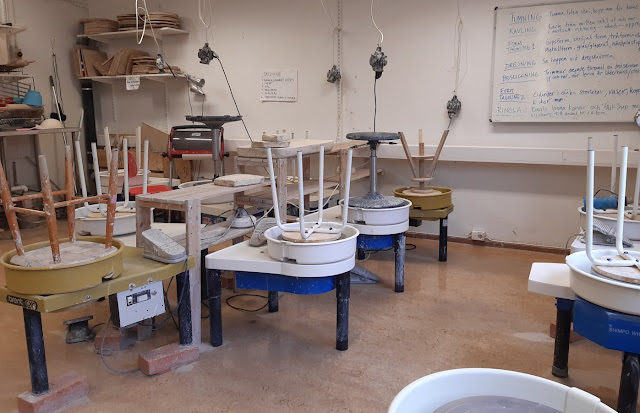I tried my hands in pottery! It has been in my 'to-do' list to try pottery and when the opportunity arose for an English-speaking pottery course at Medborgarskolan, I signed up for it. The course was split into 3 different times - a weekend (10am to 4pm) and a half-day on a Saturday (10am to 1pm). I paid SEK2995 for it. It was a bit expensive for me but I have been waiting for this for too long. In this course, myself and another lady were total beginners while the others are experienced. It felt quite demotivating for me when the person beside me was making a kettle and plate while I was struggling to make a 'pot-like' shape that does not fall.


On the first day, the instructor gave a brief introduction on pottery and informed that we will be using the 'wheel' where the wheel spins while we form a shape on it. The spinning is controlled by our foot which steps on a pedal. I learnt that there are different types of clay and today, we used black clay. The clay used is not part of the course fees that I paid. It costs SEK85/kg and I used in total, 3kg for the course. One slices the clay chunk with a wire and weighs the clay prior to using it.


Then, one massages and kneads the clay to remove the bubbles. It reminds me of kneading a bread dough. I could not take many photos while I was working with the clay. on the first day. I made several weird shapes. After a while, I got the hang of using the wheel and could make a small pot. There are two pots that I am proud of while the others are weird. The instructor said that I added too much water (one has to add water gradually while forming the shape so the clay glides from your fingers as the wheel spins) and the clay was 'tired' and the form falls. To fix that, one has to leave the clay to dry and that takes about a day but one can use a heat gun to dry the clay. At the end of the first day, we leave our creations to dry and will paint and trim as well as clean it up it on the second day.
Second day. My dried creations.

The instructor showed us how to make a pretty bottom but mine was hideous as I could not control the tool on the clay while spinning the wheel. So, I did on one pot only (look how ugly it is) and the rest of my creations had a flat bottom.

The instructor dried our creations in a huge oven (it is called a bisque kiln) so that we can glaze our creations during the third class. These are how they looked like after the drying process. I had painted one of the creations and I will glaze them with a transparent colour.

When we came back two weeks later for the final class, we glazed our creations. I chose random colours because I was not sure how it was going to turn out. I chose a matte yellow and the output was a boring colour. One can choose between shiny and matte. Now, I know why most ceramic pots are shiny. As soon as one dips the creations in the colour, the colour dries up in less than a minute and becomes powdery.

After glazing, the instructor dried for us our creations and we collected them two weeks later. Only two creations look like they have a shape and I love their colours. The shiny black and the shiny double blue colours.






So, I have done pottery and I am not keen to continue more classes. It is demovating to be surrounded by advanced or very experienced people. It would have been more fun if the students in my class are beginners and at least, we can share our mistakes. The instructor did not approach the students unless the students request the instructor's help. The instructor mentioned that she was unsure if her help was needed. I guess it is difficult from the instructor's perspective to offer one's help if most students in the class were so experienced, making it disadvantageous to the beginners.
No comments:
Post a Comment